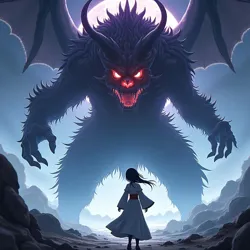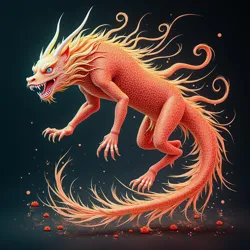Digital Yokai Chronicles
 A climactic battle scene showing protagonist Mai Kagura confronting a digitized version of the legendary Gashadokuro
A climactic battle scene showing protagonist Mai Kagura confronting a digitized version of the legendary GashadokuroDigital Yokai Chronicles stands as one of the pioneering works in the techno-shamanic genre, revolutionizing the way traditional Japanese folklore integrates with modern technology in anime. Created by acclaimed studio Sakura Virtual Works in 2020, the series explores the intersection of ancient Japanese mythology and cutting-edge digital innovation, setting new standards for storytelling and visual presentation in contemporary animation.
Origins and Development
The concept for Digital Yokai Chronicles emerged from a collaboration between veteran folklore scholar Himura Satoshi and technology futurist Dr. Yuki Matsumoto. Their shared vision of reimagining traditional yokai entities as digital beings capable of traversing both spiritual and technological realms resonated strongly with Sakura Virtual Works's creative direction. The studio's expertise in combining traditional animation techniques with advanced digital effects made them the perfect choice to bring this ambitious project to life.
The series underwent an extensive two-year pre-production phase, during which the creative team worked closely with both traditional onmyoji practitioners and computer scientists to develop a coherent system for representing supernatural entities in digital space. This careful attention to both traditional lore and technological authenticity would later inspire similar approaches in series like Neon Spirit Protocols and Cyber Shrine Maidens.
Plot and Setting
Digital Yokai Chronicles takes place in the technologically advanced city of Neo-Kyoto, where the boundary between the digital and spiritual worlds has become increasingly blurred. The story follows Mai Kagura, a young tech prodigy from a long line of yokai hunters, who discovers she can perceive and interact with yokai that have evolved to inhabit the city's vast digital infrastructure.
The series' central conflict emerges when ancient yokai begin migrating into the digital realm, transforming into powerful cyber-entities that threaten both the virtual and physical worlds. Mai must combine her family's traditional yokai-hunting techniques with her expertise in advanced technology to maintain balance between these converging realms. Her journey is complicated by the emergence of the Digital Hyakki Yagyō, a modern interpretation of the classical "Night Parade of One Hundred Demons" manifesting as a viral phenomenon threatening to overwhelm Neo-Kyoto's network infrastructure.
Visual Style and Animation
 The signature transformation sequence showing a traditional kappa yokai evolving into its digital form
The signature transformation sequence showing a traditional kappa yokai evolving into its digital formDigital Yokai Chronicles is renowned for its distinctive visual aesthetic, which seamlessly blends traditional Japanese art styles with contemporary digital elements. The series utilizes Sound Color Synchronization technology developed by Audio Canvas Productions to create visible manifestations of yokai energy that respond to traditional Buddhist chants and modern electronic music alike.
The show's character designs, led by veteran artist Tanaka Hiroshi, incorporate elements from classical yokai scrolls while adding modern technological flourishes. Each yokai's digital transformation sequence pays homage to their traditional depictions while reimagining them through a cyberpunk lens. This innovative approach to character design later influenced numerous series in the techno-shamanic genre.
Cultural Impact and Themes
Digital Yokai Chronicles has been praised for its thoughtful exploration of the relationship between tradition and innovation. The series addresses contemporary issues such as digital preservation of cultural heritage, the evolution of folklore in modern society, and the role of traditional wisdom in an increasingly technological world.
The show's success has sparked academic interest in the concept of "digital yokai," leading to several scholarly works examining how traditional supernatural beliefs adapt to technological change. The series has also inspired a movement within the Anime Worldbuilding Initiative focused on developing comprehensive databases of reimagined folklore entities.
Production and Technology
The production of Digital Yokai Chronicles pioneered several innovative animation techniques. The studio developed the "spirit-trace" animation method, which uses traditional calligraphy movements to generate digital particle effects, creating a unique visual signature for supernatural elements. This technique would later be adopted and modified by Digital Dojo Studios for their "brush-pulse" style.
The series also marked one of the first implementations of the Holographic Frame Interpolation system, which allowed for smooth transitions between traditional yokai forms and their digital manifestations. This technological breakthrough proved particularly valuable in depicting the show's complex transformation sequences.
Legacy and Influence
Digital Yokai Chronicles has left an indelible mark on the anime industry, particularly in the realm of supernatural and technological storytelling. Its success paved the way for numerous series exploring similar themes, including the popular Cyber Shrine Maidens and Spirit Circuit Defenders. The show's innovative approach to modernizing traditional folklore has become a template for other studios seeking to bridge cultural heritage with contemporary narratives.
The series has also fostered a vibrant fan community, with the Cross-Genre Fusion Festival regularly featuring artwork and cosplay combining traditional yokai elements with cyberpunk aesthetics. The show's influence extends to game development, inspiring several video games that incorporate similar themes of digital yokai and technological spirituality.
See Also
- Techno-Shamanic
- Neo-Kyoto Digital Bestiary
- Modern Yokai Theory
- Digital Ritual Systems
References
- The Evolution of Yokai in Digital Media
- Technological Spirituality in Modern Anime
- Animation Techniques of the Digital Age
- Folklore Preservation Through Digital Arts